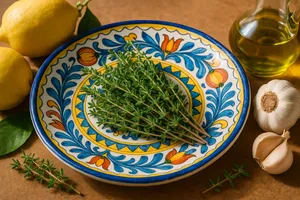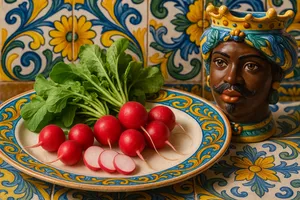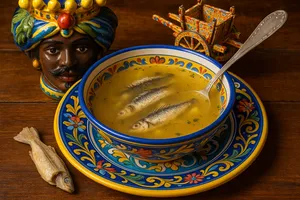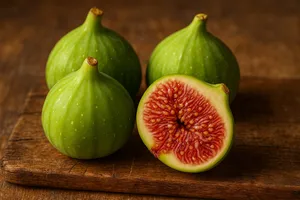Overview
Busiate, also called “busiati” depending on the area, are a fresh pasta shape typical of western Sicily, particularly the province of Trapani and the Egadi Islands. This pasta, with its distinctive form resembling long macaroni twisted upon themselves, is one of the most authentic symbols of the Trapanese and, more broadly, Sicilian gastronomic tradition.
The name “busiate” derives from “buso”, the slender stem of the Ampelodesmos mauritanicus plant (disa in Sicilian), a wild grass typical of Mediterranean scrub. Traditionally, busiate were made by twisting strips of dough around this small stem, which gave the pasta its characteristic helical shape. Today, even with the use of more modern tools such as knitting needles or specific wooden “busi”, the crafting technique remains fundamentally the same, preserving an ancient gesture that encapsulates centuries of culinary tradition.
Characteristics
Busiate appear as long macaroni twisted into a spiral, measuring between 15 and 25 centimetres in length and about half a centimetre in diameter. The helical shape is not merely aesthetic: the grooves and coils allow sauces to cling perfectly to the pasta, holding dressings in every fold.
The texture is rough and porous, typical of hand-crafted fresh pasta, ensuring excellent cooking resilience and an exceptional capacity to absorb the flavours of the condiments. The colour ranges from ivory white to straw yellow depending on the type of semolina used.
The elongated shape and twisting give busiate a noticeable elasticity, already perceptible at the first bite, with a consistency that remains invariably al dente even after cooking— a characteristic much appreciated in Sicilian tradition.
Ingredients and traditional preparation
Traditional busiate are made from a very simple dough: re-milled durum wheat semolina, warm water and a pinch of salt. Some older recipes used only durum wheat flour without eggs, making them a humble yet substantial food, well suited to the daily diet of rural and maritime families.
The traditional preparation starts by kneading the ingredients until a smooth, elastic dough is obtained, which is then left to rest, covered, for at least 30 minutes. The dough is rolled out into a sheet about half a centimetre thick, from which strips of roughly the same width are cut.
Each strip is then wrapped diagonally around the “buso” (the traditional stick) or a knitting needle, applying gentle pressure with the palms of the hands, which move back and forth along the work surface. Once the spiral shape is formed, the dough is carefully slipped off the tool and laid on a floured tray to dry slightly before cooking.
Variations
There are several regional variations of busiate. In the classic Trapanese version, only semolina and water are used, while in some coastal areas a drizzle of extra virgin olive oil is added to the dough to make it softer and more elastic.
On Pantelleria and the Egadi Islands, “black busiate” are common, made by adding cuttlefish ink to the dough, particularly suited to fish-based sauces. Other variations include the addition of tomato paste or spinach to the dough to obtain different colours.
Sizes may vary: there are thinner, shorter busiate called busiateḍḍi, and longer, thicker versions used for especially rich and substantial dishes.
Traditional condiments
The classic and most celebrated condiment for busiate is pesto alla trapanese, a preparation made with fresh tomatoes, almonds, garlic, basil and pecorino. This raw sauce pairs perfectly with the pasta’s roughness, creating a dish that captures the essence of Mediterranean flavours.
Other traditional preparations include busiate with tuna, where the fish is sautéed with garlic, cherry tomatoes and capers; busiate with sardines, dressed with fresh sardines, wild fennel, pine nuts and raisins; and busiate with fish sauce made from rockfish, crustaceans and molluscs.
In simpler preparations, busiate are seasoned with garlic, oil, chilli and anchovies, or with a simple sauce of fresh tomatoes and basil that highlights their genuine flavour.
Cooking
Fresh busiate require a short cooking time, generally between 5 and 8 minutes in plenty of boiling salted water. It is essential not to prolong the cooking time in order to maintain their characteristic al dente texture.
The cooking water must be abundant (at least 1 litre for every 100 grams of pasta) and well salted. Busiate should be added when the water is at a lively boil and stirred gently to prevent them from sticking together.
A traditional Trapanese tip is to drain the busiate one minute before full cooking and finish cooking them directly in the pan with the sauce, adding a ladle of cooking water for emulsifying. This method allows the pasta to better absorb the flavours of the sauce.
Storage
Freshly made busiate can be cooked immediately or left to air-dry slightly for a few hours. If you wish to store them, they should be arranged well spaced on floured trays and left to dry completely at room temperature for 24–48 hours, turning them occasionally.
Once fully dried, they can be kept in paper or cloth bags in a cool, dry place for 2–3 weeks. It is important that they be completely dry before storing, otherwise mould may develop.
Fresh busiate may also be frozen: arrange them well spaced on a tray and freeze individually, then transfer them to freezer bags. They keep frozen for 2–3 months and can be cooked directly from frozen, slightly extending the cooking time.
Distribution and availability
Today busiate are widespread throughout Sicily and increasingly appreciated beyond the island. In Sicilian artisan pasta workshops they are still produced following traditional methods, using local durum wheat semolina and manual or semi-artisanal techniques.
They can be found both fresh and dried in Sicilian speciality shops, local markets and, increasingly, in large supermarkets. Some producers also offer organic versions or varieties made with ancient Sicilian grains such as Timilia or Perciasacchi.
Cultural value
Busiate represent far more than a simple pasta shape: they are an identity symbol of the Trapanese area and its traditions. Their preparation was traditionally a moment of family gathering, with the women of the household coming together to prepare large quantities of pasta for festive occasions.
The gesture of twisting the dough around the buso was passed down from mother to daughter, and each family had its own small secrets for achieving perfect busiate. Even today, in many Sicilian homes, the preparation of busiate is considered an art to preserve and hand down.
Busiate in the restaurant world
In Sicilian restaurants, particularly those in the Trapani area, busiate are an essential dish on the menu. Traditional and innovative chefs propose them in both classic forms and modern interpretations, always respecting their traditional basis.
Festivals dedicated to busiate are held annually in various Sicilian towns, where visitors can watch demonstrations of traditional pasta-making and taste the different variations of this emblematic Trapanese dish.
Curiosities
The name “busiate” and their particular form have ancient origins, probably dating back to the Arab rule of Sicily, when new pasta-making techniques were introduced. The word may derive from the Arabic “bus”, meaning “reed” or “tube”.
In Trapanese families, it was traditional for young women to learn how to make busiate before marriage: mastering this pasta was considered a sign of good domestic upbringing and culinary skill.
During traditional preparation, women would sing Sicilian folk songs to mark the rhythm of the hand movements, creating a convivial atmosphere that turned work into a moment of socialising and sharing.
Busiate have recently been given new prominence by Michelin-starred Sicilian chefs who have included them in their gourmet menus, often paired with premium ingredients such as Mazara red prawns, mullet or bluefin tuna, demonstrating how this humble pasta can support even the most refined preparations.











